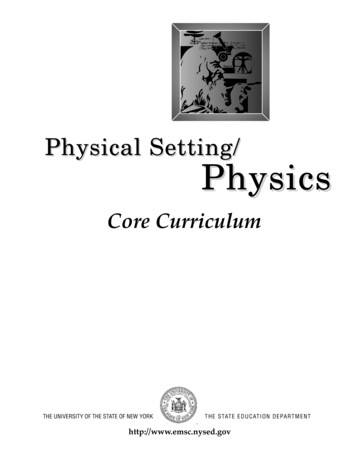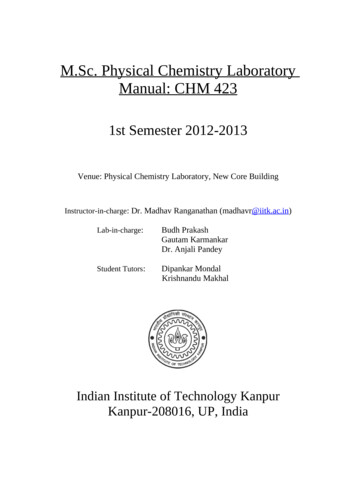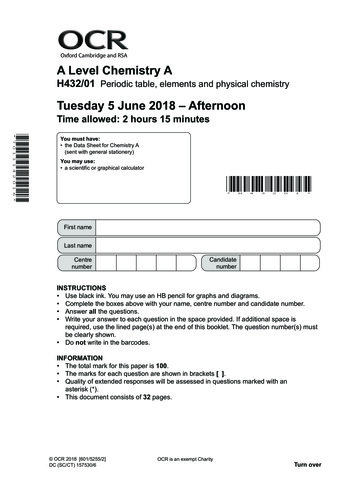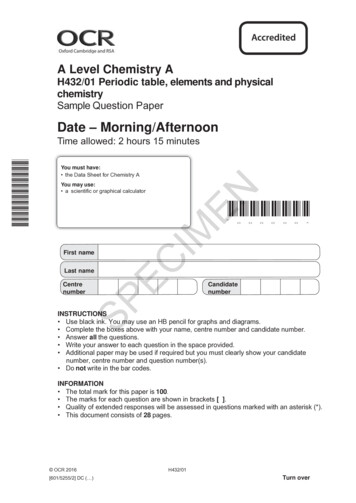
Transcription
Physical Setting/ChemistryCore CurriculumTHE UNIVERSITY OF THE STATE OF NEW YORKTHE STATE EDUCATION DEPARTMENThttp://www.nysed.gov
THE UNIVERSITY O F THE STATE O F NEW YORKRegents of The UniversityCARL T. HAYDEN, Chancellor, A.B., J.D. .ElmiraADELAIDE L. SANFORD, Vice Chancellor, B.A., M.A., P.D. .HollisDIANE O’NEILL MCGIVERN, B.S.N., M.A., Ph.D. . .Staten IslandSAUL B. COHEN, B.A., M.A., Ph.D. .New RochelleJAMES C. DAWSON, A.A., B.A., M.S., Ph.D. .PeruROBERT M. BENNETT, B.A., M.S. .TonawandaROBERT M. JOHNSON, B.S., J.D. .HuntingtonANTHONY S. BOTTAR, B.A., J.D. .NorthSyracuseMERRYL H. TISCH, B.A., M.A. .New YorkENA L. FARLEY, B.A., M.A., Ph.D. .BrockportGERALDINE D. CHAPEY, B.A., M.A., Ed.D.Belle HarborARNOLD B. GARDNER, B.A., LL.B.BuffaloCHARLOTTE K. FRANK, B.B.A., M.S.Ed., Ph.D. .New YorkHARRY PHILLIPS, 3rd, B.A., M.S.F.S. .HartsdaleJOSEPH E. BOWMAN, JR., B.A., M.L.S., M.A., M.Ed., Ed.D .AlbanyLORRAINE A. CORTÉS-VÁZQUEZ, B.A., M.P.A.BronxPresident of The University and Commissioner of EducationRICHARD P. MILLSChief Operating OfficerRICHARD H. CATEDeputy Commissioner for Elementary, Middle, Secondary, and Continuing EducationJAMES A. KADAMUSAssistant Commissioner for Curriculum, Instruction, and AssessmentROSEANNE DEFABIOAssistant Director for Curriculum and InstructionANNE SCHIANOThe State Education Department does not discriminate on the basis of age, color, religion, creed, dis ability, marital status, veteran status, national origin, race, gender, genetic predisposition or carrier sta tus, or sexual orientation in its educational programs, services, and activities. Portions of this publica tion can be made available in a variety of formats, including braille, large print or audio tape, uponrequest. Inquiries concerning this policy of nondiscrimination should be directed to the Department’sOffice for Diversity, Ethics, and Access, Room 152, Education Building, Albany, NY 12234.
CONTENTSAcknowledgments . . . . . . . . . . . . . . . . . . . . . . . . . . . . . . .ivCore Curriculum . . . . . . . . . . . . . . . . . . . . . . . . . . . . . . . .1Introduction . . . . . . . . . . . . . . . . . . . . . . . . . . . . . . . .3Process Skills Based on Standards 1, 2, 6, and 7 . . .5Process Skills Based on Standard 4 . . . . . . . . . . . .12Standard 4:The Physical Setting . . . . . . . . . . . . . . . . . . . . .16Appendix A:Chemistry Core Topics . . . . . . . . . . . . . . . . . . . . . . . .26Appendix B:Chemistry Content Connections Table . . . . . . . . . . . .34Chemistryiii
ACKNOWLEDGMENTSThe State Education Department acknowledges the assistance of teachers and school administrators from acrossNew York State and the New York State Chemistry Mentors. In particular, the State Education Department wouldlike to thank:Robert DaytonMary DeryDavid HansonLinda HobartSilvana JausCarol JemmottElaine JettyPatrick Kavanah (retired)David KieferElise Hilf LevineJoan Laredo-LiddellJune Kasuga MillerTheresa NewkirkLinda PadwaCynthia ParteeDiane PillersdorfLee RobertsLance W. RudigerDavid L. ShelcThomas ShilandVirginia M. TrombleyAlice VeyvodaBeatrice G. WerdenHarvey WeinerRush-Henrietta High School, HenriettaDutchess BOCES, PoughkeepsieSUNY at Stony Brook, Stony BrookFinger Lakes Community College, CanandaiguaEdgemont High School, ScarsdaleBishop Loughlin Memorial High School, BrooklynRavena-Coeymans-Selkirk Senior High SchoolMonroe Woodbury Senior High School, Central ValleyMidwood High School, BrooklynScarsdale High School, ScarsdaleSt. Barnabas High School, BronxQueens College, FlushingSaratoga Springs Sr. High School, Saratoga SpringsPort Jefferson High School, Port JeffersonDivision High School, LevittownRichmond Hill High School, Richmond HillWellsville High School, WellsvillePotsdam Senior High School, PotsdamPortville Jr./Sr. High School, PortvilleSaratoga Springs Senior High School, Saratoga SpringsAuSable Valley High School, ClintonvilleHalf Hollow Hills High School West, Dix HillsBronx High School of Science, BronxJohn F. Kennedy High School, BellmoreThe project manager for the development of the Chemistry Core Curriculum was Diana Kefalas Harding, Associate inScience Education, with content and assessment support provided by Sharon Miller, Associate in EducationalTesting, and Elise Russo, Associate in Science Education. Special thanks go to Jan Christman for technical expertise.ivChemistry
Physical Setting/ChemistryCore Curriculum
2Chemistry
INTRODUCTIONThe Physical Setting/Chemistry Core Curriculum has beenwritten to assist teachers and supervisors as they pre pare curriculum, instruction, and assessment for thechemistry content and process skills in the New YorkState Learning Standards for Mathematics, Science, andTechnology. This core curriculum is an elaboration of thescience content of that document and its key ideas andperformance indicators. Key ideas are broad, unifying,general statements of what students need to know. Theperformance indicators for each key idea are statementsof what students should be able to do to provide evi dence that they understand the key idea.The Chemistry Core Curriculum presents major under standings that give more specific detail to the conceptsunderlying the performance indicators in Standard 4.In addition, portions of Standards 1, 2, 6, and 7 havebeen elaborated to highlight skills necessary to allowstudents to evaluate proposed explanations of naturalphenomena. The concepts and skills identified in theintroductions and the major understandings of eachkey idea in the core curriculum will provide the mater ial from which Regents examination items will bedeveloped. Occasionally, examples are given in aneffort to clarify information. These examples are notinclusive lists. Therefore, teachers should not feel lim ited by them.This core is not a syllabus. This is a core for the prepara tion of high school curriculum, instruction, and assess ment. The lack of detail in this core is not to be seen asa shortcoming. Rather, the focus on conceptual under standing in the core is consistent with the approachesrecommended in the National Science Education Standard(National Research Council) and Benchmarks for ScienceLiteracy (American Association for the Advancement ofScience). The local courses designed using this core cur riculum are expected to prepare students to explainboth accurately and with appropriate depth conceptsand models relating to chemistry. The core addressesonly the content and skills to be assessed at the com mencement level by the Physical Setting/ChemistryRegents examination. The core curriculum has beenprepared with the assumption that the content, skills,and vocabulary as outlined in the Learning Standards forMathematics, Science, and Technology at the elementaryand intermediate levels have been taught previously.Work in grades 9-12 must build on the knowledge,Chemistryunderstanding, and ability to do science that studentshave acquired in their earlier grades.It is essential that instruction focus on the understand ing of concepts, relationships, processes, mechanisms,models, and applications. Less important is the memo rization of specialized terminology and technicaldetails. In attaining scientific literacy, students will beable to demonstrate these understandings, generateexplanations, exhibit creative problem solving and rea soning, and make informed decisions. Future assess ments will test students’ ability to explain, analyze, andinterpret chemical processes and phenomena, and usemodels and scientific inquiry. The major understand ings in this guide will also allow teachers more flexibil ity, making possible richer creativity in instruction andgreater variation in assessment. The general nature ofthe major understandings in this core will encouragethe teaching of science for understanding, rather thanfor memorization.The order of presentation and numbering of all state ments in this guide are not meant to indicate any rec ommended sequence of instruction. Ideas have notbeen prioritized, nor have they been organized to indi cate teaching time allotments or test weighting. Manyof the major understandings in this document arestated in a general rather than specific manner. It isexpected that teachers will provide examples andapplications in their teaching/learning strategies tobring about understanding of the major conceptsinvolved. Teachers are encouraged to help studentsfind and elaborate conceptual cross-linkages that inter connect many of the chemistry key ideas to each other,and to other mathematics, science, and technologylearning standards.Historical ContentThe study of chemistry is rich in historical develop ment. The learning standards encourage the inclusionnot only of important concepts but also of the scientistswho were responsible for discovering them. RobertBoyle, generally regarded as one of the fathers of mod ern chemistry, introduced systematic experimentalmethods into the study of chemistry. John Dalton laiddown the tenets of the atomic theory at the beginningof the 19th century. By mid-century Mendeleev hadcompleted most of his work organizing the Periodic3
Table, and Amedeo Avogadro had provided keeninsights into the relationships of gaseous molecules.Ernest Rutherford discovered the nucleus, and soonafterward Henry Moseley identified the atomic numberas the identifying factor of the elements. Soon after,Albert Einstein proposed the insight into the interrela tionship of matter and energy. Marie Curie workedwith radioactive substances showing natural transmu tations. Linus Pauling provided insights into the natureof the chemical bond in the 1930s, and introduced elec tronegativity values, an important tool in understand ing bonding.To successfully teach chemistry, teachers can inter weave both the concepts and the scientists who wereresponsible for discovering them. Chemistry will be farmore interesting when the human element can beincorporated into the lessons.Scientific Thinking and a Scientific MethodModern science began around the late 16th century witha new way of thinking about the world. Few scientistswill disagree with Carl Sagan’s assertion that “science is away of thinking much more than it is a body of knowl edge” (Broca’s Brain, 1979). Thus science is a process ofinquiry and investigation. It is a way of thinking and act ing, not just a body of knowledge to be acquired bymemorizing facts and principles. This way of thinking,the scientific method, is based on the idea that scientistsbegin their investigations with observations. From theseobservations they develop a hypothesis, which isextended in the form of a predication, and challenge thehypothesis through experimentation and thus furtherobservations. Science has progressed in its understandingof nature through careful observation, a lively imagina tion, and increasing sophisticated instrumentation.Science is distinguished from other fields of study in thatit provides guidelines or methods for conductingresearch, and the research findings must be reproducibleby other scientists for those findings to be valid.It is important to recognize that scientific practice is notalways this systematic. Discoveries have been madethat are serendipitous and others have not started withthe observation of data. Einstein’s theory of relativitystarted not with the observation of data but with a kindof intellectual puzzle.Laboratory RequirementsCritical to understanding science concepts is the use ofscientific inquiry to develop explanations of naturalphenomena. Therefore, as a prerequisite for admissionto the Physical Setting/Chemistry RegentsExamination, students must have successfully com pleted 1200 minutes of laboratory experience with4satisfactory reports on file. Because of the strongemphasis on student development of laboratory skills,a minimum of 280 minutes per week of class andlaboratory time is recommended.Prior to the written portion of the Regents examination,students will be required to complete a laboratory per formance test during which concepts and skills fromStandards 1, 2, 4, 6, and 7 will be assessed.The Laboratory SettingLaboratory safety dictates that a minimum amount ofspace be provided for each individual student.According to the National Science TeachersAssociation, recommended space considerationsinclude: A minimum of 60 ft2/pupil (5.6m2) which isequivalent to 1440 ft2 (134m2) to accommodate aclass of 24 safely in a combinationlaboratory/classroom.Or, A minimum of 45 ft2/pupil (4.2m2) which isequivalent to 1080 ft2 (101m2) to accommodate aclass of 24 safely in a stand-alone laboratory.It is recommended that each school district complywith local, State, and federal codes and regulationsregarding facilities and fire and safety issues.Systems of UnitsInternational System (SI) units are used in this core cur riculum. SI units that are required for the chemistrycore are listed in the Reference Tables. SI units are a log ical extension of the metric system. The SI systembegins with seven basic units, with all other units beingderived from them (see Reference Tables). While someof the basic and derived units of the SI system are com monly used in chemistry (mole, kelvin, kilogram,meter, joule, volt), there are other units that are used inchemistry that are exceptions. Thus, in addition to theSI units, you will find liters used in volume measure ments, atmospheres and torr used as pressure units,and Celsius as a temperature indicator.Uncertainty of Measurements and Significant FiguresIt is an important concept in chemistry that all mea surements contain some uncertainty. Such data isreported in significant figures to inform the reader ofthe uncertainty of the measurement. When these valuesare used in calculations, it is vital that the answers tosuch calculations are not misleading, and hence, rulesfor addition, subtraction, multiplication, and divisionshould be followed.Chemistry
PROCESS SKILLSBASED ON STANDARDS 1, 2, 6, AND 7Science process skills should be based on a series of discoveries. Students learn most effectively when they have a central rolein the discovery process. To that end, Standards 1, 2, 6, and 7 incorporate in the Chemistry Core Curriculum a studentcentered, problem-solving approach to chemistry. This list is not intended to be an all-inclusive list of the content or skillsthat teachers are expected to incorporate into their curriculum. It should be a goal of the instructor to encourage scienceprocess skills that will provide students with background and curiosity to investigate important issues in the world aroundthem.Note: The use of e.g. denotes examples which may be used for in-depth study. The terms for example and such as denotematerial which is testable. Items in parentheses denote further definition of the word(s) preceding the item and are testable.STANDARD 1—Analysis, Inquiry, and DesignStudents will use mathematical analysis, scientific inquiry, and engineering design, as appropriate, to posequestions, seek answers, and develop solutions.STANDARD 1Analysis, Inquiry,and DesignMATHEMATICALANALYSIS:ChemistryKey Idea 1:Abstraction and symbolic representation are used to communicate mathematically.M1.1 Use algebraic and geometric representations to describe and compare data. organize, graph, and analyze data gathered from laboratory activities or othersources identify independent and dependent variables create appropriate axes with labels and scale identify graph points clearly measure and record experimental data and use data in calculations choose appropriate measurement scales and use units in recording show mathematical work, stating formula and steps for solution estimate answers use appropriate equations and significant digits show uncertainty in measurement by the use of significant figures identify relationships within variables from data tables calculate percent error recognize and convert various scales of measurement temperature§ Celsius ( C)§ Kelvin (K) length§ kilometers (km)§ meters (m)§ centimeters (cm)§ millimeters (mm) mass§ grams (g)§ kilograms (kg) pressure§ kilopascal (kPa)§ atmosphere (atm) use knowledge of geometric arrangements to predict particle properties orbehavior5
STANDARD 1Analysis, Inquiry,and DesignMATHEMATICALANALYSIS:continuedKey Idea 2:Deductive and inductive reasoning are used to reach mathematical conclusions.M2.1 Use deductive reasoning to construct and evaluate conjectures and arguments, rec ognizing that patterns and relationships in mathematics assist them in arriving atthese conjectures and arguments. interpret a graph constructed from experimentally obtained data identify relationships§ direct§ inverse apply data showing trends to predict informationKey Idea 3:Critical thinking skills are used in the solution of mathematical problems.M3.1 Apply algebraic and geometric concepts and skills to the solution of problems. state assumptions which apply to the use of a particular mathematical equationand evaluate these assumptions to see if they have been met evaluate the appropriateness of an answer, based on given dataKey Idea 1:The central purpose of scientific inquiry is to develop explanations of natural phenomenain a continuing, creative process.S1.1 Elaborate on basic scientific and personal explanations of natural phenomena, anddevelop extended visual models and mathematical formulations to representSCIENTIFIC INQUIRY:thinking. use theories and/or models to represent and explain observations use theories and/or principles to make predictions about natural phenomena develop models to explain observationsS1.2 Hone ideas through reasoning, library research, and discussion with others,including experts. locate data from published sources to support/defend/explain patternsobserved in natural phenomenaS1.3 Work towards reconciling competing explanations, clarifying points of agreementand disagreement. evaluate the merits of various scientific theories and indicate why one theorywas accepted over anotherSTANDARD 1Analysis, Inquiry,and DesignKey Idea 2:Beyond the use of reasoning and consensus, scientific inquiry involves the testing of pro posed explanations involving the use of conventional techniques and procedures and usu ally requiring considerable ingenuity.S2.1 Devise ways of making observations to test proposed explanations. design and/or carry out experiments, using scientific methodology to test pro posed calculationsS2.2 Refine research ideas through library investigations, including informationretrieval and reviews of the literature, and through peer feedback obtained fromreview and discussion. use library investigations, retrieved information, and literature reviews toimprove the experimental design of an experiment6Chemistry
STANDARD 1Analysis, Inquiry,and DesignSCIENTIFIC INQUIRY:continuedS2.3 Develop and present proposals including formal hypotheses to test explanations,i.e.; they predict what should be observed under specific conditions if their expla nation is true. develop research proposals in the form of “if X is true and a particular test Y isdone, then prediction Z will occur”S2.4 Carry out a research plan for testing explanations, including selecting and devel oping techniques, acquiring and building apparatus, and recording observationsas necessary. determine safety procedures to accompany a research planKey Idea 3:The observations made while testing proposed explanations, when analyzed using conven tional and invented methods, provide new insights into phenomena.S3.1 Use various means of representing and organizing observations (e.g., diagrams,tables, charts, graphs, equations, and matrices) and insightfully interpret theorganized data. organize observations in a data table, analyze the data for trends or patterns,and interpret the trends or patterns, using scientific conceptsS3.2 Apply statistical analysis techniques when appropriate to test if chance aloneexplains the result.S3.3 Assess correspondence between the predicted result contained in the hypothesisand the actual result, and reach a conclusion as to whether or not the explanationon which the prediction is supported. evaluate experimental methodology for inherent sources of error and analyzethe possible effect on the result compare the experimental result to the expected result; calculate the percenterror as appropriateS3.4 Using results of the test and through public discussion, revise the explanation andcontemplate additional research.S3.5 Develop a written report for public scrutiny that describes the proposed explana tion, including a literature review, the research carried out, its results, and sugges tions for further research.STANDARD 1Analysis, Inquiry,and Design:ENGINEERINGDESIGNChemistryKey Idea 1:Engineering design is an iterative process involving modeling and optimization (findingthe best solution within given constraints); this process is used to develop technologicalsolutions to problems within given constraints.If students are asked to do a design project, then: Initiate and carry out a thorough investigation of an unfamiliar situation andidentify needs and opportunities for technological invention or innovation. Identify, locate, and use a wide range of information resources, and documentthrough notes and sketches how findings relate to the problem. Generate creative solutions, break ideas into significant functional elements,and explore possible refinements; predict possible outcomes, using mathemati cal and functional modeling techniques; choose the optimal solution to theproblem, clearly documenting ideas against design criteria and constraints; andexplain how human understandings, economics, ergonomics, and environmen tal considerations have influenced the solution. Develop work schedules and working plans which include optimal use and costof materials, processes, time, and expertise; construct a model of the solution,incorporating developmental modifications while working to a high degree ofquality (craftsmanship).7
STANDARD 1Analysis, Inquiry,and DesignENGINEERINGDESIGN: Devise a test of the solution according to the design criteria and perform thetest; record, portray, and logically evaluate performance test results throughquantitative, graphic, and verbal means. Use a variety of creative verbal andgraphic techniques effectively and persuasively to present conclusions, predictimpact and new problems, and suggest and pursue modifications.continuedSTANDARD 2—Information SystemsStudents will access, generate, process, and transfer information using appropriate technologies.STANDARD 2INFORMATIONSYSTEMS:Key Idea 1:Information technology is used to retrieve, process, and communicate information as atool to enhance learning.Examples include: use the Internet as a source to retrieve information for classroom use, e.g.,Periodic Table, acid rainKey Idea 2:Knowledge of the impacts and limitations of information systems is essential to itseffectiveness and ethical use.Examples include: critically assess the value of information with or without benefit of scientificbacking and supporting data, and evaluate the effect such information couldhave on public judgment or opinion, e.g., environmental issues discuss the use of the peer-review process in the scientific community andexplain its value in maintaining the integrity of scientific publication, e.g., “coldfusion”STANDARD 6—Interconnectedness: Common ThemesStudents will understand the relationships and common themes that connect mathematics, science, and technologyand apply the themes to these and other areas of learning.Key Idea 1:Through systems thinking, people can recognize the commonalities that exist among allsystems and how parts of a system interrelate and combine to perform specificInterconnectedness:functions.Common ThemesExamples include: use the concept of systems and surroundings to describe heat flow in a chemicalSYSTEMSor physical change, e.g., dissolving processTHINKING:STANDARD 68Chemistry
Key Idea 2:Models are simplified representations of objects, structures, or systems used in analysis,explanation, interpretation, or design.Interconnectedness:2.1 Revise a model to create a more complete or improved representation of the system.Common Themes show how models are revised in response to experimental evidence, e.g., atomictheory, Periodic TableMODELS:2.2 Collect information about the behavior of a system and use modeling tools torepresent the operation of the system. show how information about a system is used to create a model, e.g., kineticmolecular theory (KMT)2.3 Find and use mathematical models that behave in the same manner as theprocesses under investigation. show how mathematical models (equations) describe a process, e.g., combinedgas law2.4 Compare predictions to actual observations, using test models. compare experimental results to a predicted value, e.g., percent errorSTANDARD 6Key Idea 3:The grouping of magnitudes of size, time, frequency, and pressures or other units ofmeasurement into a series of relative order provides a useful way to deal with theInterconnectedness:immense range and the changes in scale that affect the behavior and design of systems.Common Themes3.1 Describe the effects of changes in scale on the functioning of physical, biological, ordesigned information systems.MAGNITUDE AND show how microscale processes can resemble or differ from real-worldSCALE:processes, e.g., microscale chemistry3.2 Extend the use of powers of ten notation to understanding the exponentialfunction and performing operations with exponential factors. use powers often to represent a large range of values for a physical quantity,e.g., pH scaleSTANDARD 6Key Idea 4:Equilibrium is a state of stability due either to a lack of change (static equilibrium) or abalance between opposing forces (dynamic equilibrium).Interconnectedness:4.1 Describe specific instances of how disturbances might affect a system’s equilib Common Themesrium, from small disturbances that do not upset the equilibrium to larger disturEQUILIBRIUM ANDbances (threshold level) that cause the system to become unstable.STABILITY: explain how a small change might not affect a system, e.g., activation energy4.2 Cite specific examples of how dynamic equilibrium is achieved by equality ofchange in opposing directions. explain how a system returns to equilibrium in response to a stress, e.g.,LeChatelier’s principleSTANDARD 6Chemistry9
Key Idea 5:Identifying patterns of change is necessary for making predictions about futurebehavior and conditions.Interconnectedness:Examples include:Common Themes use graphs to make predictions, e.g., half-life, solubility use graphs to identify patterns and interpret experimental data, e.g., heatingPATTERNS OFand cooling curvesCHANGE:STANDARD 6STANDARD 7—Interdisciplinary Problem SolvingStudents will apply the knowledge and thinking skills of mathematics, science, and technology to address real-lifeproblems and make informed decisions.STANDARD 7InterdisciplinaryProblem SolvingCONNECTIONS:10Key Idea 1:The knowledge and skills of mathematics, science, and technology are used together tomake informed decisions and solve problems, especially those relating to issues of science/technology/society, consumer decision making, design, and inquiry intophenomena.1.1 Analyze science/technology/society problems and issues on a community,national, or global scale and plan and carry out a remedial course of action. carry out a remedial course of action by communicating the plan to others, e.g.,writing and sending “a letter to the editor”1.2 Analyze and quantify consumer product data, understand environmental and eco nomic impacts, develop a method for judging the value and efficacy of competingproducts, and discuss cost-benefit and risk-benefit trade-offs made in arriving atthe optimal choice. compare and analyze specific consumer products, e.g., antacids, vitamin C1.3 Design solutions to real-world problems on a community, national, or global scale,using a technological design process that integrates scientific investigation and rig orous mathematical analysis of the problem and of the solution. design a potential solution to a regional problem, e.g., suggest a plan to adjustthe acidity of a lake in the Adirondacks1.4 Explain and evaluate phenomena mathematically and scientifically by formulatinga testable hypothesis, demonstrating the logical connections between the scientificconcepts guiding the hypothesis and the design of an experiment, applying andinquiring into the mathematical ideas relating to investigation of phenomena, andusing (and if needed, designing) technological tools and procedures to assist in theinvestigation and in the communication of results. design an experiment that requires t
The Physical Setting/Chemistry Core Curriculum has been written to assist teachers and supervisors as they pre pare curriculum, instruction, and assessment for the chemistry content and process skills in the New York State Learning Standards for Mathematics, Science, and










